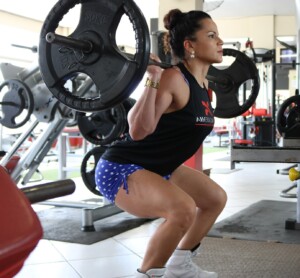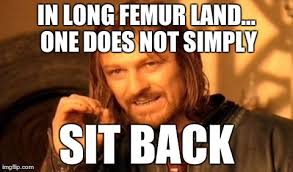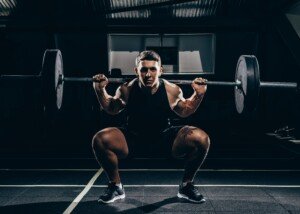There’s some false beliefs out there about long femurs, short torsos and difficulty with squats that need to be cleared up fast.
It’s bigger than I thought, all this talk about long femurs and short torsos screwing up people’s attempts to perform a halfway decent parallel back squat, let alone a full back squat.
Let’s clear up some myths surrounding the anthropometrics of the long femur to torso ratio and how it relates to breaking parallel in the back squat, as well as just going parallel.
“Tall people necessarily have long femurs.”
Well, yeah, when you consider absolute length. But the whole issue of “long femurs” and the back squat has to do with relative length of the thigh bone to the length of the torso.
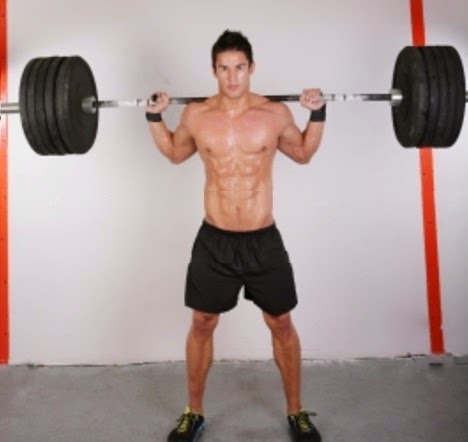
Note the exceptional “anthropometrics” here as far as squatting. This man can be any height, including 6-5. Femur length to torso length has nothing to do with overall body height.
People also forget to realize that with the tall person’s long femurs also comes a longer torso, and this typically balances things out.
Sometimes, long thigh bones go with short shin bones, but this ratio won’t interfere much with the back squat if the torso exceeds the length of the thigh bone.
A person can be 7 feet tall and still have a femur that’s much shorter than his torso, and also shorter than his shin bone.
So though the thigh bone is long in the absolute sense, it’s short in the relative sense.
“Disproportionately long femurs occur only in tall people.”
Wrong. Short people can have out of whack femur length to their body height, such as marathon runner John Kagwe (below) who stands 5-6.

Look around at your gym for further proof.
“Short people can’t have relatively long femurs.”
See above.
“People with long femurs can learn to squat upright by developing other efficiencies.”
This is a grey, fuzzy area, because some athletes can squat virtually upright due to femurs much shorter than their torsos.
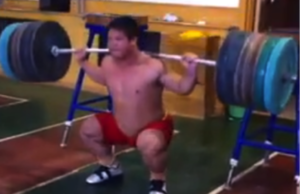
His femurs appear to be HALF his torso length!
On the other hand, “upright” to many athletes does not mean “vertical.” It means a straight back (not rounded), albeit somewhat leaned forward.
Honing hip and ankle flexibility will allow the long-femur person to lessen the vertical lean, but they will never have what is considered an upright posture during the back squat unless they use a good Sumo stance or heel elevation.
“People with long femurs should avoid doing back squats.”
There’s no reason why they shouldn’t do back squats as long as they execute excellent form and never round their back.
Having longer femurs than the torso is not a handicap (just ask any competitive cyclist, kickboxer or high jumper).
“If the femurs are longer than the torso, this is no excuse to struggle with back squats.”
Yes it is. If you can’t understand why, try this experiment. Sit in a chair at the edge where your thighs are parallel to the floor.
Lean forward and keep an arch in your lower back.
Stop when your shoulders are vertically over your ankles.
No problem, right? This assumes you don’t have “long femurs.”
You shouldn’t be that much leaned forward.
Now, to understand what someone with “long femurs” experiences, imagine that your knees protrude out a few inches more, beyond your shoulders.
This would make your ankles a few inches further from the chair. Thus, in order to align your shoulders over your ankles, you’d have to lean forward more.
Pretend, and lean forward more. And more. Keep your lower back arched.
Can you appreciate what someone with long femurs to torso must go through?
If you’re not really feeling it, then add a few more imaginary inches to your upper legs.
If you have short (relatively!) thigh bones, you may have to imagine six extra inches.
“Those with long femurs that interfere with back squats should wear Oly shoes.”
Unless you’re training for competition in which these shoes are required, there’s no need to spend all the money.
One-inch shoe inserts (targeted to people who want to appear taller) will suffice.
 Lorra Garrick is a former personal trainer certified through the American Council on Exercise. At Bally Total Fitness she trained women and men of all ages for fat loss, muscle building, fitness and improved health.
Lorra Garrick is a former personal trainer certified through the American Council on Exercise. At Bally Total Fitness she trained women and men of all ages for fat loss, muscle building, fitness and improved health.
.

